Key highlights
- Understand how a sitemap boosts search visibility and helps search engines index your site effectively.
- Explore different methods to create a sitemap, including tips on how to make a sitemap or how to generate a sitemap using plugins, online generators or manual setup.
- Learn how to submit your sitemap to Google Search Console and monitor for indexing issues.
- Avoid common sitemap mistakes like duplicate URLs, broken links and wrong formats.
- Use Bluehost’s built-in tools and plugin support to optimize and maintain your sitemap effortlessly.
Getting your website noticed in search results takes more than just publishing content. You need to help search engines navigate your site easily and that’s where knowing how to create a sitemap comes in.
A sitemap acts as a guide, showing search engines exactly which pages to crawl and index. Without it, important pages might slip through the cracks, no matter how valuable they are.
In this guide, you’ll learn why a sitemap is essential and simple steps to create one that helps boost your website’s visibility.
Let’s get started!
Why is creating a sitemap important for your website?
A sitemap acts as a roadmap that guides search engines like Google to discover all your important pages, even the ones buried deep inside your site’s homepage. In short, creating a sitemap makes it easier for search engines to understand your website.
Here’s why a sitemap matters:
- Improves search visibility: An XML (Extensible Markup Language) sitemap helps search engines index your pages faster and improves your chances of ranking in search results.
- Organizes your site’s structure: A visual sitemap shows the layout of your website, helping you and your team understand how pages connect through clear lines and boxes.
- Supports multiple content types: Sitemaps handle URLs, images, videos and additional data like update dates or priority levels, making sure nothing is missed.
- Boosts large or growing sites: When you manage multiple websites or wonder how many pages search engines can crawl, a sitemap ensures they find everything.
- Simplifies WordPress management: Plugins like Yoast automatically generate and submit XML sitemaps to Google Search Console and other search engines without coding.
For example, without a sitemap, a new blog post or project page might take weeks to appear in search results. Conversely, with a sitemap, search engines discover it faster, helping you reach your audience sooner and extract more value from your content efforts.
Also read: What is a Sitemap? How It Boosts SEO and Website Navigation.
Once you know why a sitemap is essential, the next step is learning how to create one that works best for your site.
How to create a sitemap in WordPress?
Creating a sitemap in WordPress is easier today than ever. You can use plugins for automatic sitemap generation, online tools for one-time creation or manual methods if you want full control. The best option depends on your site’s size, needs and your technical comfort level.
Here’s a quick comparison of all three methods:
| Method | Best for | Key benefits | Key limitations |
| WordPress plugins | Beginners, dynamic sites | Automatic updates, customizable | Adds plugin load to your site |
| Online generators | Quick one-time sitemaps, non-WordPress sites | No plugin needed, simple to use | Requires manual upload, no auto-updates |
| Manual creation | Designers, static sites | Full control over URLs and metadata | Time-consuming, manual updates |
Before we dive into the detailed steps, here’s the key takeaway:
For most WordPress users, plugins like Yoast SEO or Rank Math are the easiest and most reliable choice. If you only need a one-time sitemap or run a non-WordPress site, online generators work well. Manual creation is best reserved for developers or small, static websites.
Let’s begin with the most popular and beginner-friendly method using WordPress plugins to handle your sitemap automatically.
1. How to create a sitemap using WordPress plugins (Yoast SEO, Rank Math)?
With Yoast SEO:
- Go to Plugins → Add New in WordPress.
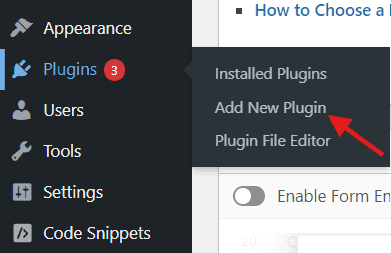
- Search Yoast SEO, click Install, then Activate.
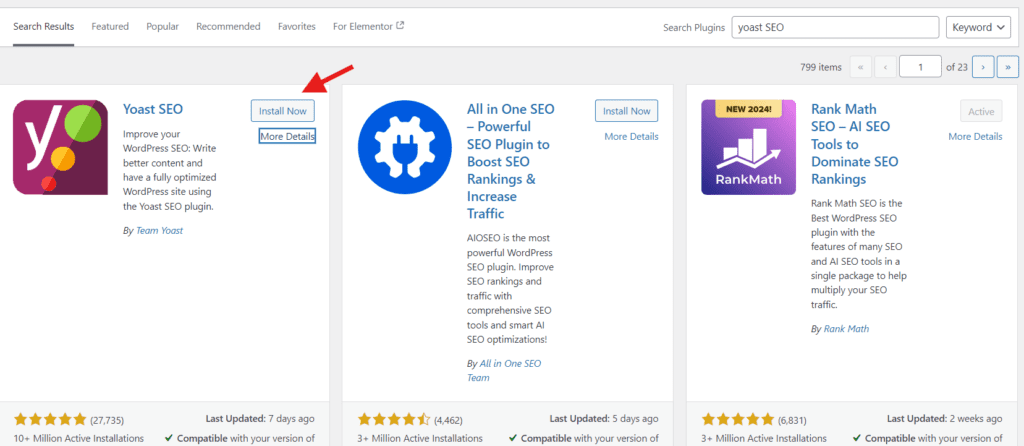
- Navigate to Yoast SEO->Settings
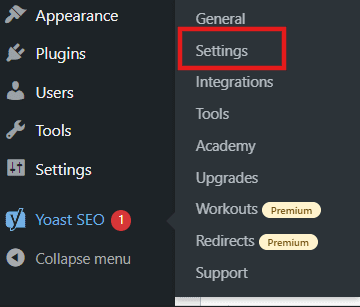
- Enable XML sitemaps.
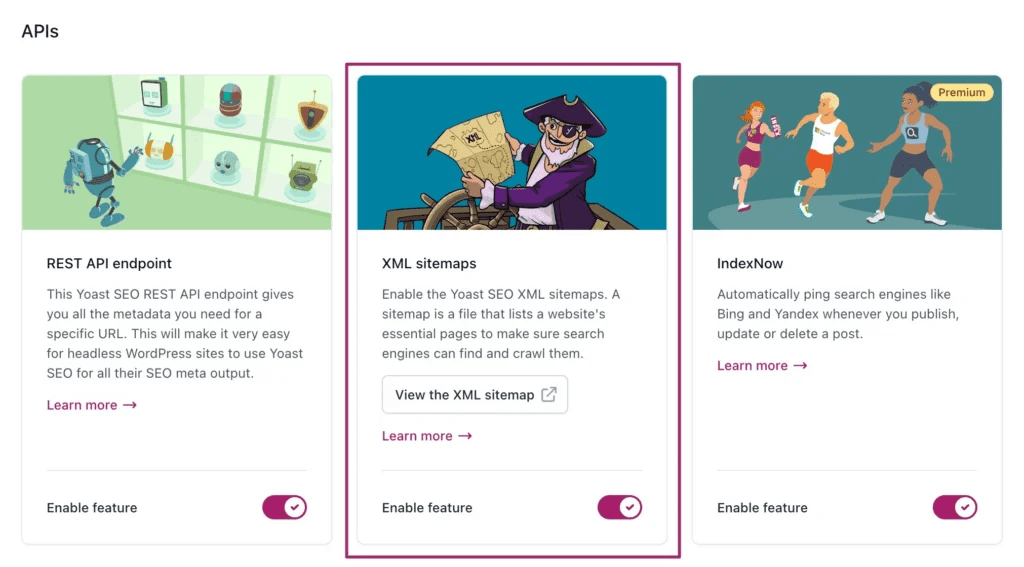
- Click the View the XML sitemap icon.
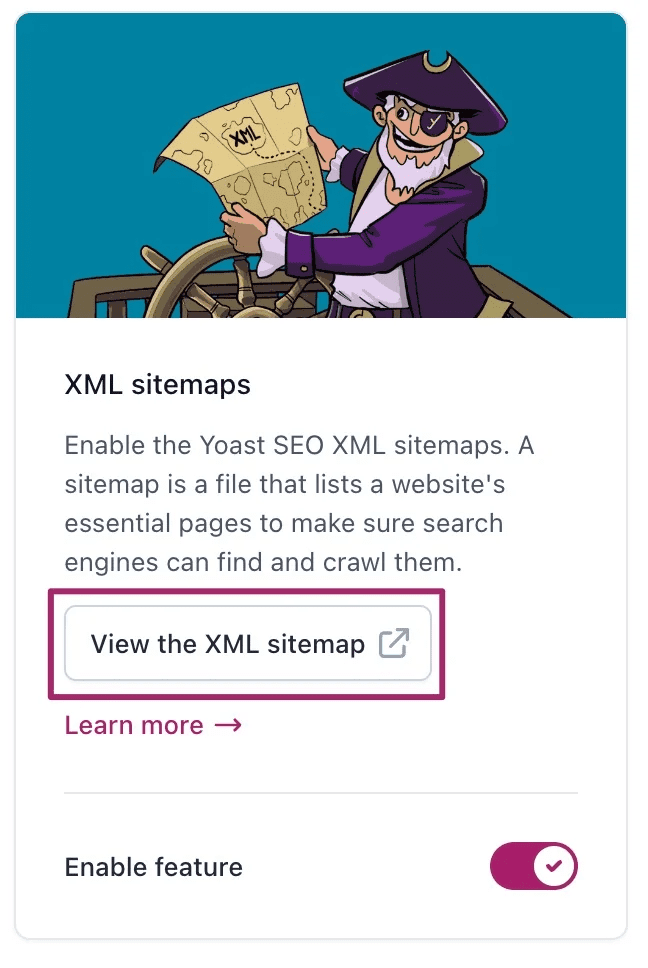
- Copy the sitemap URL (usually [yoursite].com/sitemap_index.xml) and submit it in Google Search Console.
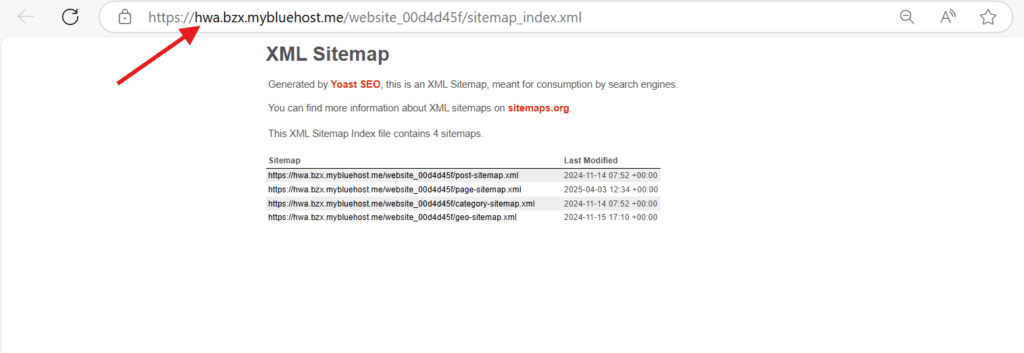
Note: Many SEO plugins also handle your RSS feed sitemap automatically, which helps search engines discover your content updates more efficiently. This type of sitemap is especially useful for news sites and frequently updated blogs.
Also read: Yoast SEO Plugin | How to use the Yoast WordPress SEO Plugin
With Rank Math:
- Install Rank Math SEO via Plugins → Add New.
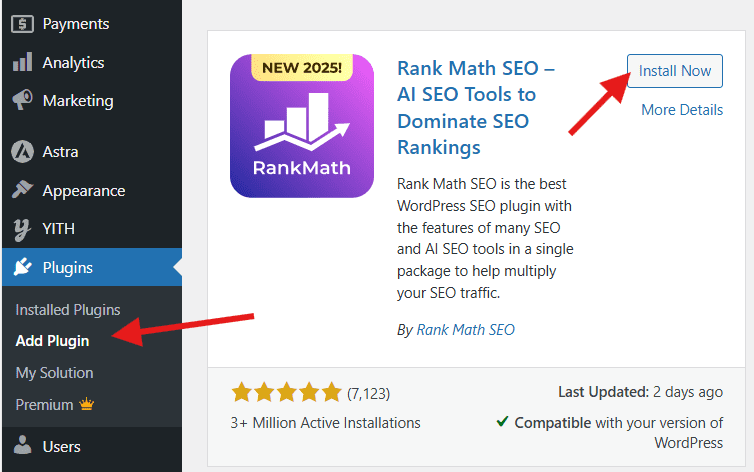
- Run the setup wizard (it appears on activation).
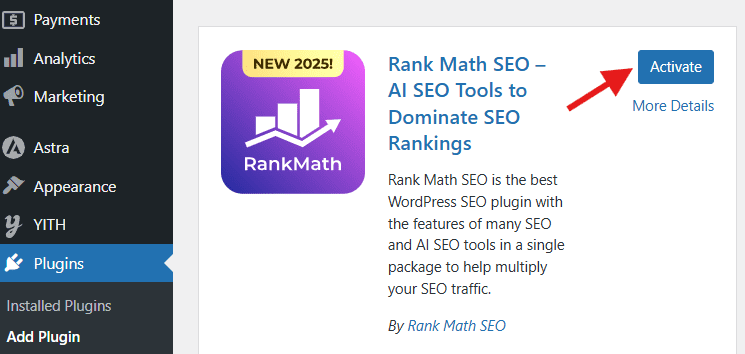
- Enable the sitemap module during setup.
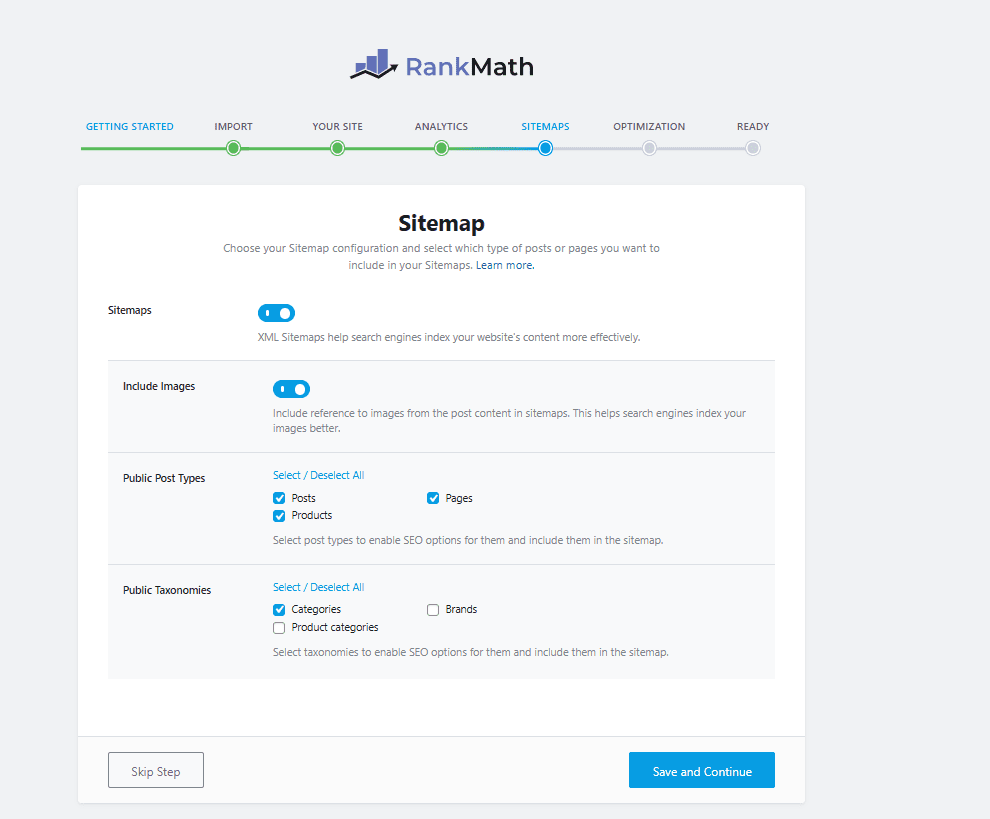
- Go to Rank Math → Sitemap Settings to adjust settings.
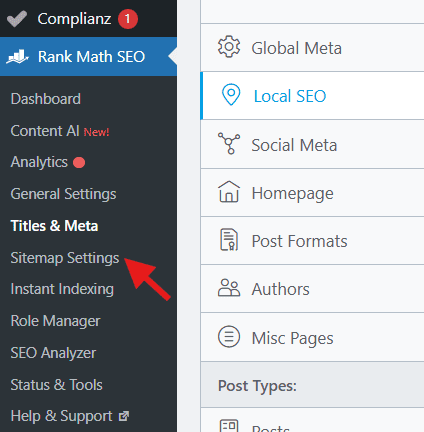
- Find your sitemap at yoursite.com/sitemap_index.xml.
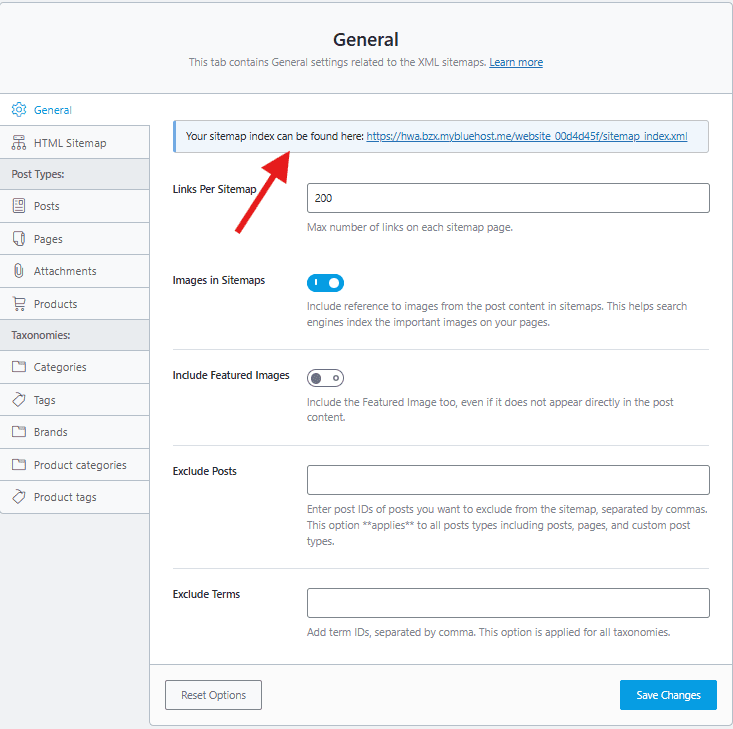
Also read: Rank Math vs Yoast SEO: Best WordPress SEO Plugin for 2025
If you prefer not to use plugins, online generators provide a simple way to create and manage your sitemap.
2. How to create XML sitemap using online generators (XML-Sitemaps, Screaming Frog)?
With XML-Sitemaps.com:
- Visit XML-Sitemaps.com.
- Enter your website URL and click Start.

- Download the sitemap.xml file.
- Upload it to your site’s root folder (public_html/) via FTP or file manager.
- Submit the sitemap URL in Google Search Console.
With Screaming Frog SEO Spider:
- Download and install Screaming Frog SEO Spider (free version available).
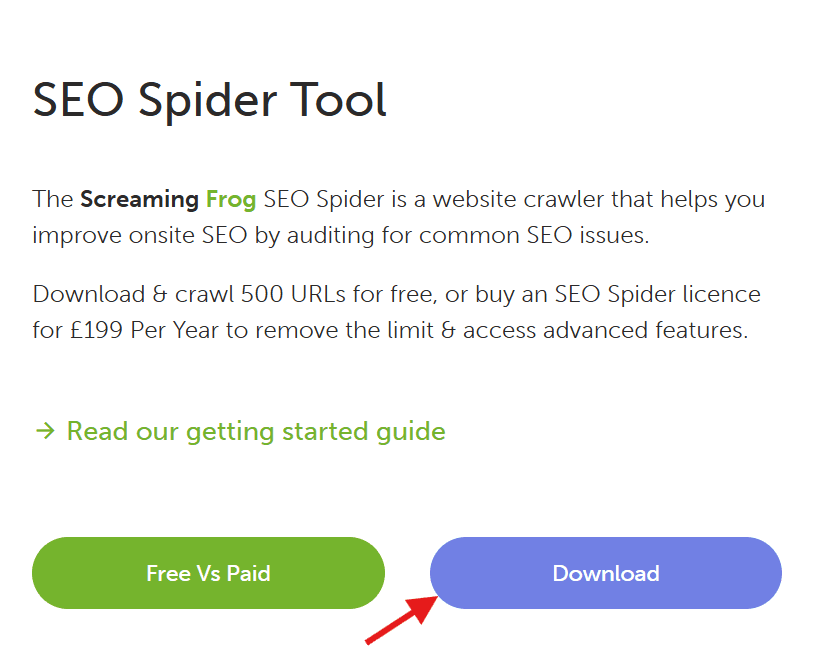
- Enter your website URL and click Start.
- After the crawl, go to Sitemaps → XML Sitemap → Export.

- Upload the file to your site’s root folder.
- Submit the sitemap in Google Search Console.
For those who want full control or are working on custom websites, creating a sitemap manually is another option.
3. How to create a sitemap manually?
- Open a text editor (Notepad, Visual Studio Code).
- Add your URLs using XML format:
<?xml version="1.0" encoding="UTF-8"?>
<urlset xmlns="http://www.sitemaps.org/schemas/sitemap/0.9">
<url>
<loc>https://yourdomain.com/</loc>
<lastmod>2025-05-08</lastmod>
<changefreq>monthly</changefreq>
<priority>1.0</priority>
</url>
</urlset>- Save as sitemap.xml.
- Upload the file to your site’s root directory.
- Submit the sitemap URL in Google Search Console.
After creating your sitemap, the next step is submitting it to search engines and making sure it works correctly.
How do you submit and validate your sitemap?
Once you create a sitemap, the next step is submitting it to search engines. This ensures search engines like Google can crawl, index and display your site properly in search results.
Here’s a quick summary of what this involves:
| Step | Why it’s important |
| Submit to Google Search Console | Let Google know where to find your sitemap and pages |
| Fix sitemap errors | Ensures all important pages are crawled without issues |
Submitting and validating your sitemap improves your site’s visibility and helps you catch any technical issues early.
1. Submitting to Google Search Console
Let’s start with submitting your sitemap to Google Search Console, the most important platform for getting your site indexed.
- Go to Google Search Console.
- Select your website property (or add it if you haven’t yet).
- In the left menu, click Sitemaps.
- Under Add a new sitemap, enter the last part of your sitemap URL (for example, sitemap_index.xml).
- Click Submit.
- Google will queue your sitemap for crawling and display its status.
Pro tip: You can also submit sitemaps to other search engines like Bing Webmaster Tools by following a similar process.
Also read: How to Submit Website to Search Engines. Get Indexed Fast in 2025
2. Fixing sitemap errors and warnings
After submission, you may see errors or warnings. It’s important to fix these quickly so search engines can index your content.
- Go to Sitemaps → Submitted sitemaps in Google Search Console.
- Check the status column for “Success,” “Has issues,” or “Couldn’t fetch.”
- Click on the sitemap to view details.
Look for common errors like:
- URLs blocked by robots.txt
- 404 (Not Found) pages
- Redirect loops or broken links
- Incorrect sitemap format
To fix these errors, start by reviewing your sitemap status in Google Search Console and identifying the specific issues.
Fix the issue by:
- Updating or removing broken URLs from the sitemap.
- Correcting sitemap file format (if created manually).
- Updating your text if it’s blocking important pages.
- Regenerating the sitemap using your plugin or generator if needed.
- Resubmitting the sitemap in Google Search Console.
Pro tip: After fixing errors, use the URL Inspection tool in Search Console to test individual pages and make a note of any persistent issues.
Along with creating and submitting a sitemap, it’s helpful to understand how your hosting can support the process. Here’s how Bluehost helps:
How does Bluehost help you optimize your sitemap with built-in tools and plugins?
Bluehost makes it easy to manage and optimize your sitemap, especially on WordPress. Here’s how:
1. Preinstalled WordPress with sitemap-ready setup
When you install WordPress through Bluehost, it automatically generates a basic sitemap (yoursite.com/wp-sitemap.xml) — no extra plugins needed.
2. Seamless Yoast SEO and Rank Math integration
Bluehost fully supports top SEO plugins like Yoast SEO and Rank Math. These tools let you control which pages appear in your sitemap and automatically notify Google and Bing of updates.
3. Fast server response for better crawling
With Bluehost’s optimized hosting, search engines can crawl your sitemap quickly, improving indexing performance.
Create a WordPress site with an SEO-ready sitemap — Try Bluehost WordPress Hosting and get started in minutes!
4. Helpful Google Search Console guides
Bluehost offers clear resources to help you submit your sitemap and monitor it through Google Search Console.
With the right tools in place, it’s just as important to avoid common pitfalls that can limit your sitemap’s effectiveness.
What are the most common sitemap mistakes to avoid?
Even a well-built sitemap can fail if it has avoidable mistakes. Fixing these issues helps search engines crawl your site smoothly and improves your chances of ranking well.
Let’s look at the most common sitemap mistakes and how to avoid them.
1. Duplicate URLs in your sitemap
Duplicate URLs waste search engines’ crawl budget and can confuse indexing.
Why it’s a problem: Search engines may crawl the same page multiple times, lowering efficiency.
How to avoid it:
- Scan your sitemap regularly using Yoast SEO, Rank Math or Screaming Frog.
- Remove duplicate URLs before submitting the sitemap.
2. Outdated or broken URLs
Outdated URLs that return 404 errors or lead to redirected pages can hurt your site’s SEO health.
Why it’s a problem: Search engines may lower your site’s crawl priority and trust.
How to avoid it:
- Review your sitemap after removing, updating or redirecting pages.
- Use Google Search Console to identify broken links.
- Regenerate your sitemap after major updates.
3. Using the wrong sitemap format
Submitting a sitemap in the wrong format can cause errors or rejection.
Why it’s a problem: Search engines expect a valid XML sitemap and may ignore unsupported formats like a simple text file sitemap or incorrectly formatted XML file.
How to avoid it:
- Use trusted plugins like Yoast SEO or generators like XML-Sitemaps.com.
- Validate your sitemap before submitting it using Google’s sitemap testing tool.
- Always submit the .xml file, not HTML or visual sitemaps.
Final thoughts
Creating a sitemap is one of the smartest steps you can take to improve your website’s visibility and SEO performance. When you understand how to create a sitemap for website and keep it updated, you help search engines discover your best content faster and more efficiently.
Take the time to choose the right tools, avoid common mistakes and regularly monitor your sitemap’s health. With the right setup, you’ll set your site up for long-term success.
If you’re looking for reliable hosting with seamless WordPress integration and top-rated SEO tools, Bluehost can help you build and grow your site with confidence.
Launch your sitemap-ready WordPress site now!
FAQs
You should update your sitemap whenever you add, remove or significantly change pages on your site. If you use WordPress plugins like Yoast SEO or Rank Math, your site maps will update automatically, so you don’t have to worry about manual changes.
Yes! Even small websites benefit from a sitemap. It helps search engines crawl and index your web pages efficiently, especially if you have a new site with limited backlinks or a simple structure.
Absolutely. With tools like Yoast SEO, Rank Math or online sitemap generators, you can create a sitemap without writing code or Java script knowledge. These tools handle the technical details for you and provide an easy-to-use interface.
Sitemap errors can prevent search engines from indexing your website pages correctly. Common issues include broken URLs, duplicate entries or incorrect formatting. You can monitor and fix these errors using Google Search Console, then resubmit the sitemap once resolved.
To edit an existing sitemap, you can either use your SEO plugin’s settings to modify which categories and content types are included or manually update the .xml file. After making changes, be sure to complete the process by resubmitting the updated website’s sitemap to search engines.



Write A Comment